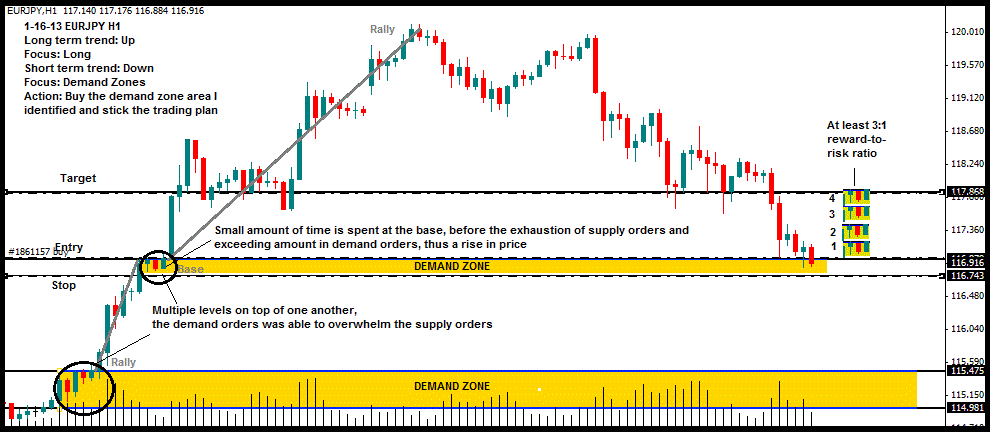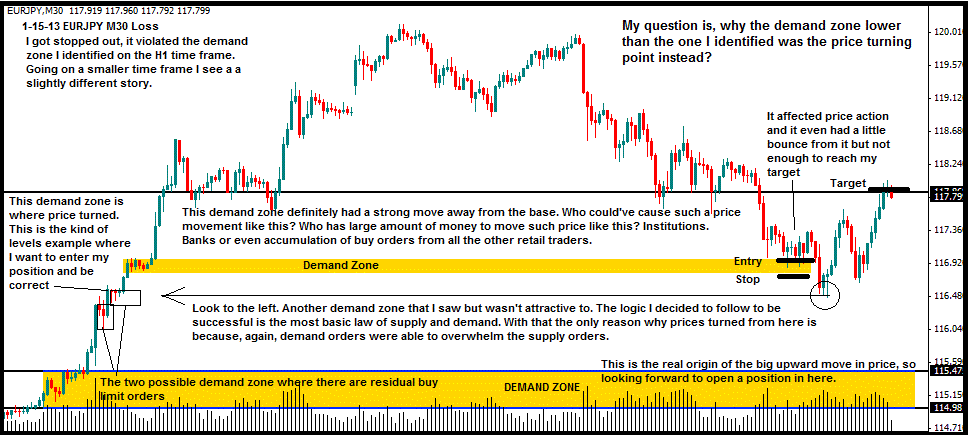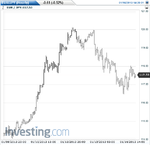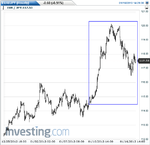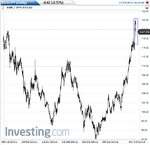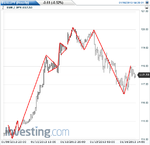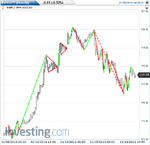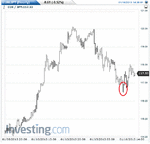.
You're with me so far. That helps. Now look at this a bit more closely. The chart below is the same as the chart above only color-coded (I'm not fond of color-coding, but, in this case, it helps to clarify things) and somewhat more detailed on the most recent downswing.
After the waves themselves, the most important thing to look at is the comparative lengths, i.e., which waves are of greater length and duration? Clearly the buying pressure has the upper hand on the way from the lower-left of the chart up to the top. There are a couple of breathers along the way (the triangles or coils or hinges), but this can't be unexpected after all. Nor is it surprising that they should come so close together since the first one took so long to form. Their message, however, should not be overlooked, that indecision is setting in, and a turning point may be in the offing.
Be that as it may, notice also that the buying waves are getting shorter as you near the turning point. Think of pushing a car uphill, and getting more tired as you go, even with rest breaks. Notice further that after the turning point, the first sell wave is longer than the immediately preceding buy wave (even if you extend that last buy wave to the last triangle to fill the gap, they are at least equivalent, which is also noteworthy). Then, when a rally is attempted, not only is the buy wave shorter than the immediately preceding sell wave, but price also fails to make a higher high, or even reach the immediately preceding high. This does not necessarily mean in and of itself that you ought to go short. You don't after all know that it's going to be a lower high until price has dropped below the last swing low, which it does eventually, but you don't know that at the time. And price did find support at the apex of that last triangle. Perhaps there will be one more try at a higher high, and then you'll be left standing there with your short, missing the continuation.
Which brings me to hindsight analysis. All sales pitches, regardless of the form they take, rely on hindsight analysis. Which in and of itself is not evil. Hindsight analysis is very useful when illustrating principles and when backtesting and forward-testing setups. And I've seen some outstanding hindsight analyses. But it does not necessarily follow that the vendors and fanboys who provide them can walk the walk in real time. Purchasers of these programs and courses and software and so forth find out rather quickly that what is so impressive and so clear in the presentation just doesn't work when the pedal meets the metal. Unfortunately they too often come to the conclusion that they just don't understand it as well as they thought they did, so they go back to the well, buying more DVDs and signing up for more courses. But it doesn't get better, largely because the sales pitch is crap.
Always keep in mind, then, that you must put everything you learn from a hindsight analysis into the context of real-time trading. When the salesman says that such and such is the top, how will you know that in real time? How can he know it without knowing the future (which, of course, all hindsight analysts know)? How can he know that, for example, a selling or buying climax is present without knowing what happens afterwards? If he can't explain any of that to your satisfaction, put your wallet back in your pocket (you are, of course, in a free trial) and walk away.
So back to the chart.
You could of course short the lower high, but by the time you determine that it is in fact a lower high it may be too late for you to enter without assuming more risk than you're comfortable with. Which brings us back to the waves. Note that the selling wave that immediately follows the lower high is longer than the immediately preceding buying wave. This tells you that, for the moment, sellers are in charge. And if you approach this with some understanding of trader psychology, you'll know that this sort of thing empowers sellers and short-sellers and rattles buyers. Thus when the next buying wave is so short and doesn't even reach half the length of the preceding selling wave, the odds for a successful short shift a bit in your favor.
Which brings us to the subject of determining when and where the balance shifts again, the downtrend looks to be over, and the odds shift back to the long side. But that's another chart, which has to include what occurred after you uploaded this one. In the meantime, think about what I've said here and ask your questions.

